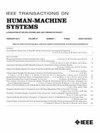基于自适应递归PID自整定滤波器的人随动控制方法
IF 4.4
3区 计算机科学
Q2 COMPUTER SCIENCE, ARTIFICIAL INTELLIGENCE
引用次数: 0
摘要
人类跟随机器人的研究对实际应用具有重要意义。它是人机技术的一个热点领域。本文提出了一种基于视觉自整定滤波器的自适应递归比例积分微分(PID)控制算法,以解决在存在遮挡、多人或变形的情况下对特定跟随目标识别精度不足的问题。进一步提高人类跟随机器人的控制精度和免疫能力。首先,获取基于深度相机的红绿蓝(RGB)图像和深度图像。人员再识别算法和YOLOv8算法用于检测和跟踪目标。利用深度图像计算目标的空间位置信息。此外,还构建了方向比例微分(PD)控制器和速度比例积分(PI)控制器。它的基础是用户和机器人的相对姿态之间的差异。为了使传感器数据波动最小化,减少相对位置不稳定性的负面影响,开发了一种自整定滤波器。为了在历史窗口中记住机器人和用户之间的相对姿态,提出了一种自适应循环机制。控制器具有根据当前系统状态自适应输出控制量的能力。最后,通过实验验证了所提方法的可靠性。实验结果表明,本文提出的视觉行人跟踪算法具有很强的适应性。与传统PID、分数阶PID和虚拟弹簧模型相比,我们的方法在转向场景下的平均距离误差分别降低了64.29%、57.14%和60.52%,在直线行驶场景下的平均距离误差分别降低了42.86%、40.00%和40.00%。本文章由计算机程序翻译,如有差异,请以英文原文为准。
Human-Following Control Method Based on Adaptive Recurrent PID Controller With Self-Tuning Filter
The research on human-following robot is important for practical applications. It is a hot field of human–machine technology. This article proposes an adaptive recurrent proportional integral differential (PID) control algorithm with self-tuning filter based on vision to address the issue of insufficient recognition accuracy of specific following targets in the presence of occlusion, multiple people, or deformation. It also aims to further improve the control accuracy and immunity of a human-following robot. First, a depth camera-based red green blue (RGB) picture and a depth image are acquired. The person reidentification algorithm and the YOLOv8 algorithm are used to detect and track the targets. The spatial position information of the targets is calculated by the depth image. Additionally, the orientation proportional differential (PD) controller and the speed proportional integral (PI) controller are built. Its foundation is the discrepancy between the relative posture of the user and the robot. In order to minimize sensor data fluctuations and lessen the negative impacts of relative positional instability, a self-tuning filter is developed. To remember the relative postures between the robot and the user in the history window, an adaptive recurrent mechanism is suggested. The controller has the ability to output the control quantity in an adaptive manner based on the current system state. Finally, experiments are conducted to verify the reliability of the proposed method. The experimental findings demonstrate that the visual pedestrian tracking algorithm proposed in this article is highly adaptable. Compared to the traditional PID, fractional-order PID, and virtual spring model, our method demonstrates significant enhancements, reducing the average distance error by 64.29%, 57.14%, and 60.52% in steering scenarios, and by 42.86%, 40.00%, and 40.00% in straight-ahead scenarios, respectively.
求助全文
通过发布文献求助,成功后即可免费获取论文全文。
去求助
来源期刊

IEEE Transactions on Human-Machine Systems
COMPUTER SCIENCE, ARTIFICIAL INTELLIGENCE-COMPUTER SCIENCE, CYBERNETICS
CiteScore
7.10
自引率
11.10%
发文量
136
期刊介绍:
The scope of the IEEE Transactions on Human-Machine Systems includes the fields of human machine systems. It covers human systems and human organizational interactions including cognitive ergonomics, system test and evaluation, and human information processing concerns in systems and organizations.
 求助内容:
求助内容: 应助结果提醒方式:
应助结果提醒方式:


